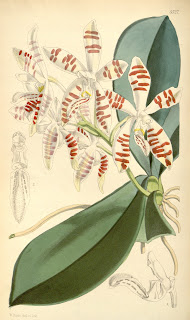The Sumatran Phalaenopsis
Endemic to the lowland forests of Sumatra, Borneo, Malaysia and the Philippines. Flowers are somewhat variable, both in colour and the intensity of their markings. Previously classified as a separate species, Phalaenopsis zebrina is now considered to be synonymous with the Phalaenopsis sumatrana species.Overview
Common Name: The Sumatran Phalaenopsis
Subgenus, section: Polychilos, Zebrinae
Distribution: Sumatra, Borneo, Malaysia, the Philippines
Light: Bright diffuse light
Temperature: Warm
Water: Wet dry cycle
Size: Small to medium
Flowering Season: Spring to Autumn
Flower size: <5cm
Scent: Mildly fragrant
Light: Bright diffuse light
Temperature: Warm
Water: Wet dry cycle
Size: Small to medium
Flowering Season: Spring to Autumn
Flower size: <5cm
Scent: Mildly fragrant
Varieties:
- Phal. sumatrana var. alba (possibly synonymous with Phal. tetraspis var. alba)
- Phal. sumatrana var. paucivittata
CULTURE
Phalaenopsis sumatrana can be grown mounted bare root or in pots in an all-purpose orchid bark mix. If mounted, they will require high humidity and misting several times a day to stay hydrated. Consider placing sphagnum moss under & around the roots for moisture retention if you decide to mount the plant. If potted, use a clear pot to keep an eye on the health of the roots and consider adding extra ventilation holes for aeration.
Water abundantly in warmer weather, about once a week for potted plants, depending on your environment, allowing the media to dry slightly between waterings. Take care not to let the plant sit in water or for the medium to become soggy, as this is likely to lead to root rot. This is why clear pots are particularly ideal for phalaenopsis and other epiphytic orchids.
Fertilising should be done 'weakly, weekly' (1/4-1/2 strength) during active growth. As with all phals, when using commercial fertilisers, be sure to flush out any excess salt build-up by running water through the pot once a month or so as the excess salts can desiccate or burn the plant's roots.
In regards to temperature, Phal. sumatrana is a thermophilic species. Temperatures below 15°C should be avoided as this will typically hinder growth and cause bud blast. Sudden drops in temperature or prolonged periods of 10°C or below can result in cold damage. One primary symptom of cold injury is sunken yellow spots on leaves with a soft, watery feel, which can often turn brown or black and rot.

Comments
Post a Comment